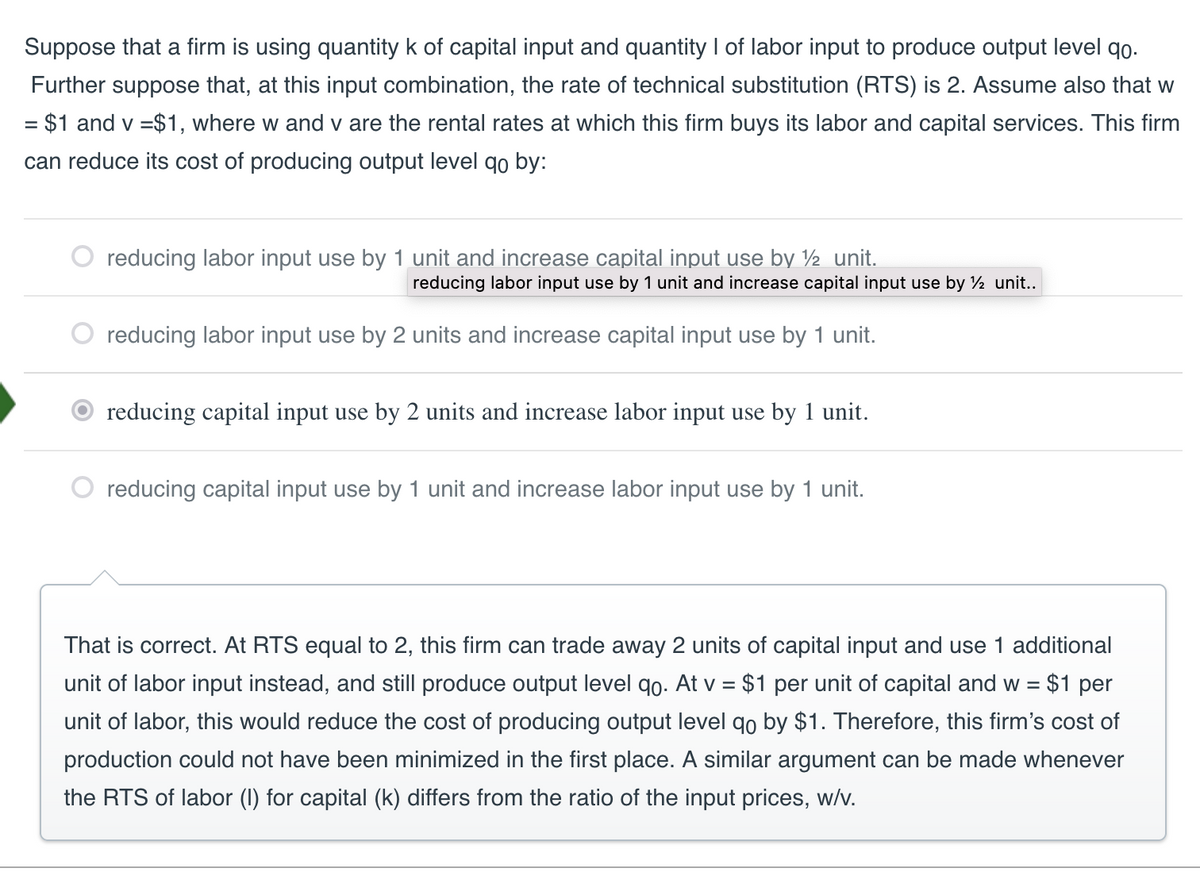Suppose that a firm is using quantity k of capital input and quantity I of labor input to produce output level qo. Further suppose that, at this input combination, the rate of technical substitution (RTS) is 2. Assume also that w = $1 and v = $1, where w and v are the rental rates at which this firm buys its labor and capital services. This firm can reduce its cost of producing output level qo by: reducing labor input use by 1 unit and increase capital input use by ½ unit. reducing labor input use by 1 unit and increase capital input use by ½ unit.. reducing labor input use by 2 units and increase capital input use by 1 unit. reducing capital input use by 2 units and increase labor input use by 1 unit. reducing capital input use by 1 unit and increase labor input use by 1 unit. That is correct. At RTS equal to 2, this firm can trade away 2 units of capital input and use 1 additional unit of labor input instead, and still produce output level qo. At v = $1 per unit of capital and w = $1 per unit of labor, this would reduce the cost of producing output level qo by $1. Therefore, this firm's cost of production could not have been minimized in the first place. A similar argument can be made whenever the RTS of labor (1) for capital (k) differs from the ratio of the input prices, w/v.
Suppose that a firm is using quantity k of capital input and quantity I of labor input to produce output level qo. Further suppose that, at this input combination, the rate of technical substitution (RTS) is 2. Assume also that w = $1 and v = $1, where w and v are the rental rates at which this firm buys its labor and capital services. This firm can reduce its cost of producing output level qo by: reducing labor input use by 1 unit and increase capital input use by ½ unit. reducing labor input use by 1 unit and increase capital input use by ½ unit.. reducing labor input use by 2 units and increase capital input use by 1 unit. reducing capital input use by 2 units and increase labor input use by 1 unit. reducing capital input use by 1 unit and increase labor input use by 1 unit. That is correct. At RTS equal to 2, this firm can trade away 2 units of capital input and use 1 additional unit of labor input instead, and still produce output level qo. At v = $1 per unit of capital and w = $1 per unit of labor, this would reduce the cost of producing output level qo by $1. Therefore, this firm's cost of production could not have been minimized in the first place. A similar argument can be made whenever the RTS of labor (1) for capital (k) differs from the ratio of the input prices, w/v.
Chapter9: Production Functions
Section: Chapter Questions
Problem 9.10P
Related questions
Question
100%
How would the answer change if w = 5. (see image attached)

Transcribed Image Text:Suppose that a firm is using quantity k of capital input and quantity I of labor input to produce output level 9o.
Further suppose that, at this input combination, the rate of technical substitution (RTS) is 2. Assume also that w
= $1 and v = $1, where w and v are the rental rates at which this firm buys its labor and capital services. This firm
can reduce its cost of producing output level qo by:
reducing labor input use by 1 unit and increase capital input use by ½ unit.
reducing labor input use by 1 unit and increase capital input use by ½ unit..
reducing labor input use by 2 units and increase capital input use by 1 unit.
reducing capital input use by 2 units and increase labor input use by 1 unit.
reducing capital input use by 1 unit and increase labor input use by 1 unit.
That is correct. At RTS equal to 2, this firm can trade away 2 units of capital input and use 1 additional
unit of labor input instead, and still produce output level qo. At v = $1 per unit of capital and w = $1 per
unit of labor, this would reduce the cost of producing output level qo by $1. Therefore, this firm's cost of
production could not have been minimized in the first place. A similar argument can be made whenever
the RTS of labor (I) for capital (k) differs from the ratio of the input prices, w/v.
Expert Solution
This question has been solved!
Explore an expertly crafted, step-by-step solution for a thorough understanding of key concepts.
This is a popular solution!
Trending now
This is a popular solution!
Step by step
Solved in 3 steps

Knowledge Booster
Learn more about
Need a deep-dive on the concept behind this application? Look no further. Learn more about this topic, economics and related others by exploring similar questions and additional content below.Recommended textbooks for you



Economics (MindTap Course List)
Economics
ISBN:
9781337617383
Author:
Roger A. Arnold
Publisher:
Cengage Learning



Economics (MindTap Course List)
Economics
ISBN:
9781337617383
Author:
Roger A. Arnold
Publisher:
Cengage Learning
